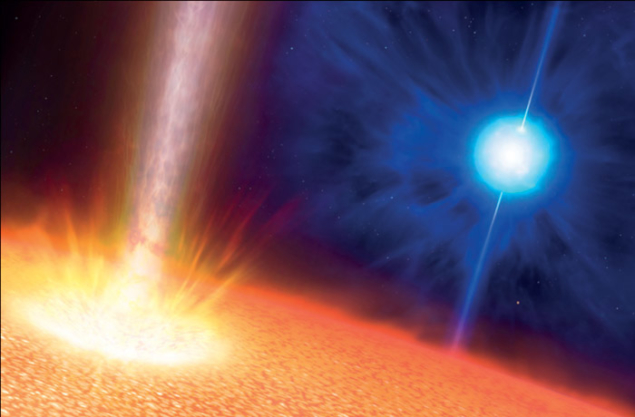Three unusually long-lasting stellar explosions discovered by NASA’s Swift satellite represent a new class of gamma-ray bursts (GRBs). Astrophysicists conclude that they probably arose from the catastrophic death of supergiant stars hundreds of times larger than the Sun.

Image credit: Mark A Garlick, used with permission by the University of Warwick.
GRBs are extremely powerful flashes of gamma rays observed from a random direction on the sky about once a day. They are traditionally classified as short – and long-duration events. Short bursts last 2 s or less and are thought to represent a merger of compact objects (neutron stars or black holes) in a binary system. Long GRBs last up to several minutes and are probably associated with the birth of a black hole during the supernova explosion of a massive star (CERN Courier September 2003 p15). Both scenarios give rise to powerful jets that propel matter at nearly the speed of light in opposite directions. As they interact with matter in and around the star, the jets produce a spike of high-energy radiation (CERN Courier December 2005 p20).
While most of the thousands of GRBs observed so far fall into these two categories, there are also peculiar sub-energetic bursts (CERN Courier September 2004 p13) and unrelated gamma-ray events that arise from the tidal disruption of a star by a supermassive black hole (CERN Courier July/August 2011 p14). Now, three recent GRBs with extremely long duration are making astronomers consider an additional category.
The first evidence of the need for a new class of GRB came from the analysis of GRB 111209A, which erupted on 9 December 2011 and remained active for 7 hours as observed by NASA’s Swift spacecraft and several other gamma-ray, X-ray and optical instruments. The detailed study, led by Bruce Gendre while at the Italian Space Agency’s Science Data Centre, shows that the burst is a genuine GRB at a redshift of z = 0.677 but with an outstanding long duration and a high total flux.
An earlier event, GRB 101225A, exploded on Christmas Day 2010 and produced high-energy emission lasting at least two hours. Because the distance to this atypical GRB was unknown, astronomers thought that this so-called “Christmas burst” could be of a radically different nature. One group suggested an asteroid or comet falling onto a neutron star within the Galaxy, while another team suspected a merger of a neutron star with an evolved giant star to be at the origin of the burst. Both scenarios are disproved by the recent measurement of the redshift of the host galaxy by Andrew Levan of the University of Warwick and his team. They place the Christmas burst 7000 million light-years away (z=0.847), implying that the burst was far more powerful than first thought. Levan and colleagues link it with the similar GRB 111209A and another recent burst, GRB 121027A, all of extremely long duration.
Both studies propose that the ultralong duration of such atypical bursts is related to the size of the collapsing star. The duration of the event would be proportional to the time that it takes for matter to fall towards the new-born black hole at the stellar core or for the particle jets to drill their way through the star. In either case, the bigger the star the longer the duration. The likely candidates for ultralong GRBs would thus be supergiant stars with a size of hundreds of times the Sun’s diameter. Gendre’s team goes further, suggesting that GRB 111209A marked the death of a blue supergiant containing modest amounts of elements heavier than helium. This would imply that ultralong-duration GRBs would have been much more common in the distant past of the universe, when matter was not yet enriched in the heavy elements produced by massive stars.







